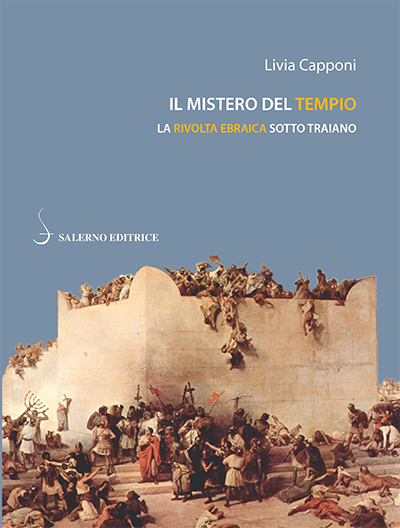How we would love to know more about the times between the fall of Jerusalem in 70 CE and the crushing of the Bar Kokhba revolt in 135 CE. That period is surely a decisive one for how both Christianity and Judaism developed into what they are today. Some have suggested that this period saw the actual births of both Judaism and Christianity as distinct religions in the forms we recognize today.
We have Josephus to inform us about the first Jewish war of 66-73 CE. But we have no comparable contemporary historians of the Bar Kokhba war and only scant hints about “troubles” in the in-between time. We recently posted a series on Thomas Witulski’s thesis that the Book of Revelation was written in response to the events in the times of Trajan and Hadrian, in particular the days of the Bar Kokhba rebellion. In that series we saw that the red horse and its rider in the apocalypse arguably represented the widespread uprisings of Jews in the time of Trajan and the black horse and especially the pale horse depicted the horrific consequences of those revolts (around 115-117 CE).
There is straight narrative history that interprets known events from the reliable sources. The facts are rarely in doubt but their meaning and significance may be open to debate.
There is historical work that analytically dissects statistics.
There is investigative history that seeks to uncover “what really happened”, such as when there is an interest in settling some current controversy, such as how indigenous peoples were treated by imperial powers.
And then there are hypothetical reconstructions based on a fresh interpretation of sources. This last type is not “an established fact” in the sense we can say “Caesar was assassinated in 44 BC”, so it will be open to debate. Readers will want to know the grounds for the various details proposed and I hope to make those clear in these posts.
The historian Livia Capponi has attempted to fill in that gap with her reconstruction of events in what she describes as “a circumstantial history” (“una storia indiziaria” (p. 75). Her book is published in Italian and is titled, in English, Mystery of the Temple — the Jewish Revolt Under Trajan = Il Mistero Del Tempio: La Rivolta Ebraica Sotto Traiano (2018).
The basic argument presented is this:
- Before the revolts of 116-117 CE relations between Rome and Judea were unstable but not openly hostile.
- In 96 CE the emperor Nerva abolished an odious tax on Jews and initiated a policy of relative tolerance.
- The next emperor, Trajan, sought the support of the Jews (as part of his efforts to safeguard his supply line in his war against Parthia) by authorizing the preparation of a road for exiles to return to Judea and a promise to rebuild the Temple in Jerusalem.
- If messianic expectations were aroused in the wake of Trajan’s policies they soon turned violent when it was learned that Trajan’s tolerance included the integration of the proposed temple into the Greco-Roman pantheon. There is evidence that Trajan and his general Lusius Quietus (we met him briefly in the post on the red horse) dedicated monuments to pagan gods in Jerusalem.
Some readers will be aware that I have expressed doubts that there were popular messianic movements extant in Judea or the Diaspora prior to 70 CE — remarks about a “world ruler from the Orient” in Josephus and others notwithstanding. (See posts listed under Second Temple Messianism.) But there is evidence that messianic hopes were alive after the catastrophe of 70 CE. Messianic pretenders do seem to appear across the landscape. Such has been my view so I was particularly keen to read Capponi’s thesis about that time.
Livia Capponi has taken a fresh look at the sources — Jewish and others, both primary and secondary — and attempted to uncover what can be learned about the feelings of Jews at this time and what was happening that led to the widespread violence and its bitter aftermath.
Above all, an attempt is made to explain how, from an initial policy of tolerance and an attempt by Trajan to mend the trauma of the loss of the Temple in 70 through Jewish initiatives, he arrived at the bloody repression of the revolt, which swept away the Jewish communities from Egypt, Cyrene and Cyprus, and which led rabbinic literature to portray Trajan as ‘the wicked one’. The compromise of the Temple was probably associated with a form of ‘integration’ of the Temple itself into the Greco-Roman pantheon, evidenced by the construction in Jerusalem of statues and monuments to the emperor and to deities such as Jupiter and Serapis. This policy, normal for the Romans, but aberrant and unacceptable to the Jews, probably explains why Trajan and his general Lusio Quieto in Jewish sources were associated with Antiochus IV Epiphanes of Syria, author of the desecration of the Temple in 167-164 BC, and the Syrian general Lysias. The Diaspora revolt was in the eyes of the Jews a new Maccabean revolt.
The hypothesis is presented and discussed through a re-reading of the historiography on the years 115-117 (in which many problems still exist, also due to incidents in the transmission of sources), and of contemporary documents (papyri and inscriptions). Finally, an attempt is made to integrate into the framework of the Western sources some suggestions drawn from texts composed in a Jewish environment, materials that are extremely difficult because they are enigmatic and expressions of a religious conception, not a desire for historical reconstruction.
(pp. 11f, translation)
I will be posting some of the details from Livia Capponi’s book over the next few weeks.
Capponi, Livia. Il mistero del tempio. La rivolta ebraica sotto Traiano. Rome: Salerno, 2018.
